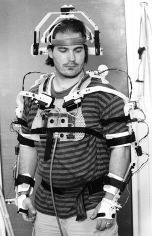
What's a Waldo, Anyway?
Harry Medved
"The Waldo will do to puppetry
what the word processor did to the typewriter," predicts
puppeteer Rick Lazzarini. He should know. Lazzarini is a
pioneer in the field of the "Waldo" technique, one of the
many new ways to electronically manipulate puppets. This
mechanical gizmo detects the movements of an off-screen
performer and automatically duplicates them in an
on-screen animatronic creature. A current yet somewhat
exaggerated example of the use of a Waldo can be seen in
the special effects extravaganza FX2, in which Bryan
Brown manages to fight a foe by remotely instructing his
Waldo-operated clown dummy to kick and punch the
unsuspecting villain. The real Waldo puppets have been
used in productions as diverse as Ghostbusters II,
Radio Flyer, Teenage Mutant Ninja Turtles and TV's
Dinosaurs.

Rick Lazzarini in a "Waldo"
suit
Before their application in motion pictures and
television, "Waldos'' primarily referred to the
mechanical arms, telemetry', and other anthropomorphic
gadgetry aboard the NASA spacefleet. NASA engineers in
turn took the name from a l940 Robert A. Heinlein novella
about a disabled scientist named Waldo who built a robot
to amplify his limited abilities.
One of the first wizards to use a Waldo-type device
for filmed entertainment was the late Jim Henson in his
prime-time Muppet revue. In one memorable episode of
The Jim Henson Hour, he introduced an amazing bird
character (whose name was - you guessed it - Waldo) that
could change shape, size, and color on command. Such a
metamorphic critter could not possibly have been enacted
by a live actor in a suit or by a performer utilizing a
three-dimensional puppet. The off-camera Waldo bird was
physically manipulated by a puppeteer, wearing a skeletal
framework 20 to 30 feet away from the actual set. Through
the magic of computers the featured star appeared in the
same frame with the show's human headliners. The Waldo
device was so successful that it was re-used on several
Fraggle Rock episodes as well.
When faced with the challenge of making a head of
lettuce spring to life for a Kraft salad dressing
commercial, puppeteer Lazzarini experimented with a new
kind of Waldo - one that reproduced facial gestures.
Lazzarini contrived a kind of Rube Goldberg contraption
that was straight out of a Steven Spielberg movie. He
glued sensors to a helmet over his head, affixed sensor
probes to his face, routed wires from his helmet's sensor
board into a computer circuit board, and attached
"servomotors" which acted a s a puppet's "muscles." When
he raised his left eyebrow, his on-camera creature lifted
its left eyebrow. Lazzarini also found ways to transmit
signals to the puppet for head tilts, jaw and lip
movements, and smiles. This technique gave puppets the
ability to realistically project actors' emotions.
"For the full range of effects you can get with these
new puppets, say's SAG Puppeteers Chair Eren Ozker, "you
would normally need four or five performers operating
remote control devices. The real beauty of the Waldo is
that it enables a single puppeteer to control the
character's movement, facial features, and body language.
It allows even the most fantastical character to interact
with live actors. It also cuts down on the amount of
heavily choreographed rehearsal that would otherwise be
required and t he puppeteer can be more spontaneous in
his or her performance.
Actors who are worried about losing jobs to an
invasion of Waldos should rest assured. "You will always
need a performer to operate the mechanisms," says Ozker
"because it's not enough for a character to come alive.
It must also give a dramatic performance and that's
something only an actor's sensibility can provide."
Lazzarini agrees. "You need a puppeteer with a
particularly expressive, rubbery face, or else your
character is going to be rather boring. The Waldo takes
the onus of the technical process a way from the
puppeteer, so that you can concentrate on the content of
your performance, rather than worrying about 'Who's on
the eyes?'"
If these new gizmos are not going to replace actors,
what about traditional puppets and marionettes? SAG
Puppeteers Committee Co-Chair Tony Urbano replies, "There
will always be a place for traditional hand, string and
rod manipulation. The challenge for contemporary
puppeteers is to add the new electronic technology to
their puppeteering abilities." SAG Puppeteers officer Tim
Blaney offers, "Puppet technology is constantly evolving
- tomorrow it could be laser manipulation. But the basic
art and work of the puppeteer remains the same to project
a characterization through whatever controls are being
used to give an inanimate object the illusion of
life."

